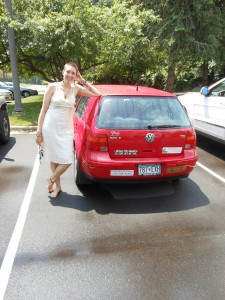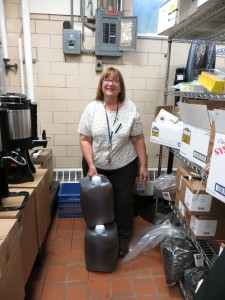This Fuelish Fellow Commutes on Veggie Oil
I love road trips. The word freedom for me conveys images of being behind the wheel, an open road in front of me, and no agenda to keep.
But driving is hard on the conscience, when much of my work and life are shaped around activism and education focused on environmental and social justice issues. America’s quest for oil is a root cause of wars in the Middle East and environmental disasters such as the BP oil spill, and it continues to be a hot-button political and conservation issue.
Since I first heard it was possible, it has been a dream of mine to own a car that runs on waste vegetable oil — burning a resource widely regarded as trash. And finally, last summer, I was able to make that dream a reality.
On my college visits around the Midwest as Bon Appétit Management Company Foundation’s Midwest Fellow, I would ask around about anyone involved in waste vegetable oil (WVO) conversions, keeping my ears open for any possible leads. This is how I found Joey Antolik of Full Circle Fuels, located right down the street from Oberlin College, which supplies him with WVO. Joey claims to be the No. 1 installer of WVO systems in the U.S.
I am an avid believer of “doing it yourself,” but doing my own conversion was way outside my DIY comfort level.Having to take a bunch of mechanical engineering classes in college may have made me slightly more qualified than the average Joe, but I did not trust myself with something this big.On top of that, most conversions are done on old “beater” BMWs from the ’80s, but in light of how much I drive, I had intentionally invested in a car that would last me much longer: a 2004 Volkswagen Golf TDI. I was NOT about to let anyone but a professional — thus excluding myself — touch my Charlene. (Yes, my car is named Charlene.)
Diesel engines naturally can run on WVO, so converting a car entails installing both a separate fuel tank for the WVO in the trunk and switches that enable the driver to go back and forth between WVO and diesel. The car is started and shut down on diesel to keep from gumming up the engine, but once the engine reaches operating temperature I can switch over to WVO.
The WVO barely needs to be processed at all before Charlene can use it. After I pick it up, I try to let it sit for at least a week so that any water can separate out.Once there is a clear line (the good, gold oil will be at the top with all the sludge and water at the bottom), I just filter it through a 10- micron sock filter with a setup I made from used cat litter containers with holes cut in them. Then it’s good to go!
I pick up the used fryer grease from Bon Appétit cafés: my first supplier was Oberlin College, and since then I’ve picked up grease from Albion College, Trine University, and Medtronic, plus Carlson Towers when I’m home. Farmer Mark Hidding is my main supplier when I’m in Minneapolis: people donate oil to him along with kitchen scraps, so it’s easy for him to put it right back in the five-gallon containers it came in and save it for me instead. Then, when I go to pick it up, I drop back off the waste (all the sludge and particles I filtered out) to be fed to the pigs.
I love being able to show up for a college visit and say I got there by burning fryer grease from Bon Appétit. It is just one more way I can live out Bon Appétit’s commitment to sustainability everyday in my work as a Fellow.

